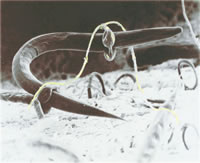Benefits of a Living Soil
1. Retain nutrientsin soils so they do not leach or volatilise. These nutrients include nitrogen, phosphorous, potassium and calcium. The reduction or complete removal of inorganic fertiliser applications is possible and highly desirable when a Healthy Soil Foodweb is present.
2. Cycle nutrients into the right forms at the correct rates for the plant desired. The right ratio of fungi to bacteria is needed for this to happen, as well as the correct volaume and activity of biological predators (eg Protozoa and Nematodes).
3. Build soil structure so that oxygen, water and nutrients can easily move through the soil and into deep, well-structured root systems.
Current concepts of plant root systems as being predominately present in the surface layers of the soil are the result of recent agricultural and urban practices and subsequent compaction levels in soils.
Roots should go down into the soil for at least several to tens and perhaps hundreds of metres, but the soil compaction layers that human activity has created have led to toxic anearobic materials being produced. This compaction and toxicity prevents deep and robust root penetration.

Pictured right: The turf sample to the left has an unhealthy root system prior to compost tea. Images to the right show roots at one and two applications of compost tea. Roots grow denser, deeper, hold soil and build soil structure.
A correct way to deal with compaction problems is to have the biological communities rebuild the structure in the soil again which will then allow oxygen and water to infiltrate through the soil.
When the biology is functioning properly water demand is reduced, the need for fertilisers is reduced and plant production is increased. Significant cost-benefits are found after initial investment in composting or application of brewed liquid biological solutions (for example compost tea).

4. Suppress disease-causing organisms through competition with beneficial nematodes, by setting up the soil and foliar conditions to favour the beneficial nematodes. For example, root-feeding nematodes are controlled by beneficial nematode species as in the attached picture. (photo: courtesy of Soil Foodweb International).
6. Produce plant-growth-promoting hormones and chemicals. This can result in the plant growing larger root systems.
 Australian Dollars
Australian Dollars
 US Dollars
US Dollars
 European Euros
European Euros
 New Zealand Dollars
New Zealand Dollars
